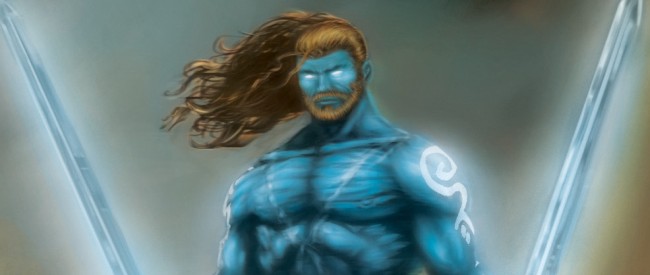 “Welcome to Scotland’s first superhero!” is the proud proclamation in the introduction to this first edition of Saltire, the new independently published project looking to provide Scottish readers with their very own identifiable icon among the capes, cowls and costumes brigade. Now, depending on your defining criteria of what constitutes a super-hero of course, I suspect that’s an assertion that continuity buffs would probably argue with. However, what can’t be contested is that there has never been a super-hero book that puts a Scottish protagonist front and centre in quite the way that Saltire does, embracing a robust sense of national identity as an integral part of its premise.
“Welcome to Scotland’s first superhero!” is the proud proclamation in the introduction to this first edition of Saltire, the new independently published project looking to provide Scottish readers with their very own identifiable icon among the capes, cowls and costumes brigade. Now, depending on your defining criteria of what constitutes a super-hero of course, I suspect that’s an assertion that continuity buffs would probably argue with. However, what can’t be contested is that there has never been a super-hero book that puts a Scottish protagonist front and centre in quite the way that Saltire does, embracing a robust sense of national identity as an integral part of its premise.
Initial publicity states that Saltire is a title that will jump timeframes with the possibility that story arcs could be set in any pivotal moment in Scotland’s history. The opening instalment, Book One: Invasion, takes place on the border with England and is set during the Roman incursion of the British Isles. The tribes of the Valleys of Light and their Highland counterparts to the North have assembled their mystical champions to repel the invaders of the Ninth Legion, invoking the land’s ultimate guardian – the powerful hero known as Saltire. But the Roman masses have their own supernatural warrior and Saltire will soon find himself facing the magical might of the godly Mars Ultor…
Backing up this initial skirmish is Book Two: Inception which fleshes out the history of writer John Ferguson’s fantasy universe, providing an origin for Saltire as an embodiment of all the people of Scotland and setting up plenty of plot points for this world which I’m sure are intended to provide the foundation for future story arcs. Without wanting to give away the finer plot points of this back story it’s here that we learn of the sacrifice that provided the catalyst for Saltire’s creation, his connections to the tribes of the land, and his relationship with the Fae of the Ethereal Realm.
Separating the explanations from the action is an astute storytelling choice, preventing the critical events of Book One becoming bogged down in exposition and allowing for a more leisurely, carefully paced examination of the intricate realms that Ferguson has fashioned in the second book. As my fellow Broken Frontier columnist Josh Finney pointed out recently, in his Cultural Barbwire column here, super-heroes and self-publishing are a difficult sell. I don’t completely discount the genre in ‘Small Pressganged’ but if I am going to cover them then they have to provide something a little different in either presentation or premise from the standard DC/Marvel fare. See my reviews of Rol Hirst and Rob Wells’s Department of the Peculiar, T’sao Wei’s Windrush, Martin Eden’s Spandex or Jamie Gambell and Andrew Maclean’s Department O for examples of the type of work with its roots in the super-hero world that fit the bill. And, in that respect, there was more than enough to keep my attention here. 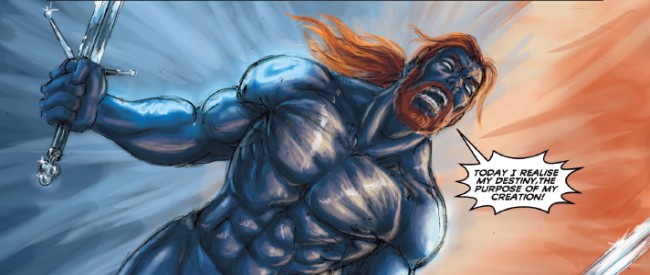 What’s interesting about this introductory story arc is that it has even been branded as a super-hero book at all. The basic concept behind the title fuses a number of genre elements. The pre-publicity evoked the likes of Braveheart and Lord of the Rings and, indeed, the comic is founded on the notion of meshing the mythological with the historical to create a fantastical alternative past. While it seems likely that future issues will more readily involve the storytelling devices of the super-hero tradition this opener fits more snugly into the realms of fantasy. If you were put off by the overt use of “super-hero” in the book’s marketing then rest assured that, at this point anyway, there’s far more to Saltire than masks, secret identities and crimefighting.
What’s interesting about this introductory story arc is that it has even been branded as a super-hero book at all. The basic concept behind the title fuses a number of genre elements. The pre-publicity evoked the likes of Braveheart and Lord of the Rings and, indeed, the comic is founded on the notion of meshing the mythological with the historical to create a fantastical alternative past. While it seems likely that future issues will more readily involve the storytelling devices of the super-hero tradition this opener fits more snugly into the realms of fantasy. If you were put off by the overt use of “super-hero” in the book’s marketing then rest assured that, at this point anyway, there’s far more to Saltire than masks, secret identities and crimefighting.
The strengths in Saltire’s initial set-up then are its major hook in providing a read grounded firmly in a specific national identity, the possibilities inherent in a narrative that can shift through critical points in history, and the world-building groundwork Ferguson has made such a central plank of his concept. There’s potential in the structure of the Saltire universe – let’s go the whole hog and use the language of the super-hero world – to move beyond rigid genre confines and provide storytelling opportunities that are more expansive in scope; to its credit this isn’t just standard super-heroics. Whether Saltire capitalises on what differentiates it from the mass of super-hero comics already out there is something only time will tell, but early signs are promising that we have something that is going to tread its own path here.
Where the book does struggle a little at this point is in the dialogue department. Too often characters are rather obviously describing the plot rather than speaking in a flowing, naturalistic manner and that comes across as somewhat stilted in places. It’s also abundantly clear that there are so many pieces on the board in terms of cast that there’s no chance at this juncture to elaborate on characterisation. With such a densely populated first couple of episodes that is, perhaps, an inevitability but I would hope that in issues to come as much time is devoted to establishing individual characters as it is to the series’ bigger picture.
If you visit the Saltire site you can see in more detail the rather interesting background on how the book’s art team was acquired. Pleasingly, Gary Welsh and Tone Julskjaer’s art is atypical of the usual traps that super-heroics fall into visually. In the first chapter they effectively contrast the remote and harsh rural setting with the realms of magic and legend. In Book Two the art is slightly looser but with the mystical side of the arc more in evidence here it gives this section a more otherworldly feel to it which is appropriate in the circumstances. I was reminded in places of the work that rested between the covers of some of the classic British weeklies of yesteryear. For those who do enjoy the more dynamic aspects of super-heroes, though, fret not: there’s plenty in the way of powerful fight scenes here if that’s a prerequisite for your super-hero buying habits.
What John and editor Clare Ferguson have set up in Saltire has the promise to rise above the clichés associated with costumed heroes and develop into something altogether more appealing and epic than the usual “men in tights punching each other” nonsense. A focus on richer characterisation will lead to the readership becoming more invested in the sprawling cast of characters but a solid groundwork is there ready to be built on. And, even if none of the above persuades you to give Saltire a look, then can I just mention that there are thought bubbles in this comic?! That, alone, is enough to keep me watching for future issues…
For more on Saltire visit the comic’s website here. Saltire is available to buy here priced £9.99 and is published by Diamondsteel Comics.





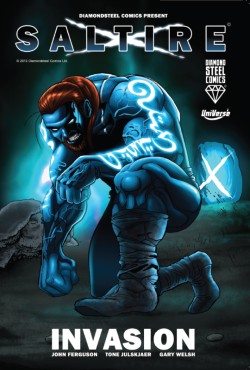
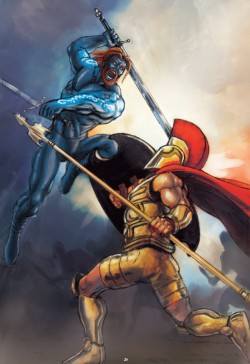
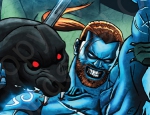

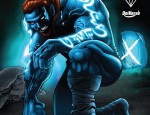
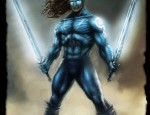
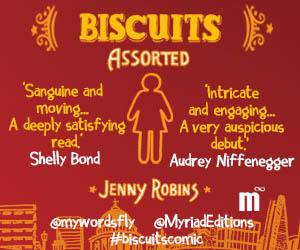





[…] embracing a robust sense of national identity as an integral part of its premise,” notes Andy Oliver of Saltire in his recent review on Broken Frontier. “… super-heroes and self-publishing are a difficult sell. I don’t completely […]